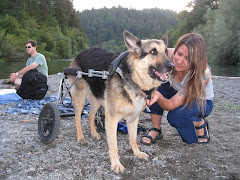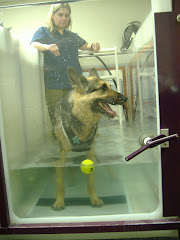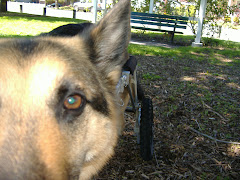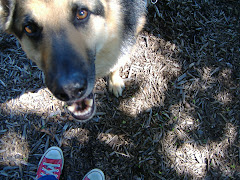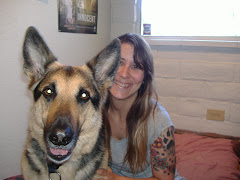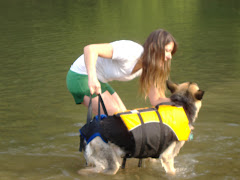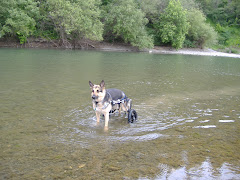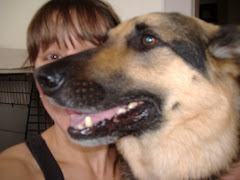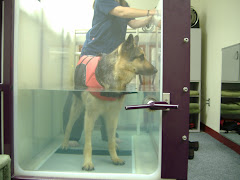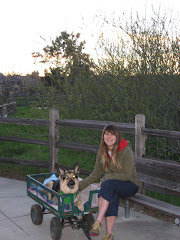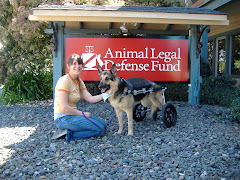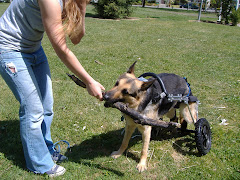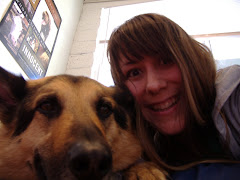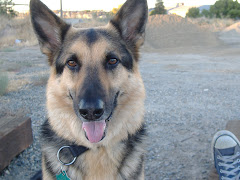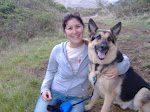
He is still not allowed to run or get rambunctious on land (it is a balance with which I continually struggle – letting him be a dog and not being overprotective, yet remaining cautious and mindful to prevent further injury), but he loves to chase the ball in the water and this summer has been a blessing. I have taken him swimming in the rivers around Portland at least once, and often multiple times, a week. This is the #1 reason I am sad to see this summer slip away. I took him swimming once per week last winter but it was so cold he could only swim for about 20 minutes, whereas this summer he has been able to swim for unlimited amounts of time. There is an indoor warm water swimming facility in Vancouver, Wash., about 30 miles from Portland, called Unsinkable Dogs that I am going to look into for when the weather turns cold. The tanks look pretty small in the photos on their website, so I’m not sure if he will have room to chase the ball, but I will give it a try. I hate to see his happy days in the water come to an end. Maybe we need to move somewhere with an all-year-around warm climate – just so he can swim everyday! In all seriousness, I probably would move us somewhere warmer if I could - preferably near a pristine river or lake with a flat sandy bank - but alas, my job is here. And I suppose there are colder places than Portland, though it didn't feel that way last winter!
A word about serendipity… back in June, Alec developed pressure sores from the cart that became infected. It happened really quickly, like overnight. At this point he was still using his wheelchair for longer walks and I was also taking him for short round-the-blocks about once per day. But due to this skin infection the vet told me I should keep him out of the cart for a couple weeks to allow his skin to heal. When I heard this, I was crestfallen. Would he get enough exercise without being able to use the cart? He was barely walking around the block at that point. Well, those weeks were a turning point, and the infection was a blessing in disguise, because by the end of those weeks, I realized he didn’t really need the cart anymore! He was able to walk longer and longer and seemed to be getting sufficient exercise from walking on his own, and he has only used it once since then. While it was always my goal for him to make the transition to exclusively walking on his own, and this is what we were working toward, being forced to keep him out of the cart for a period of time certainly expedited the revelation that it was possible and he was ready.
I have mentioned the steady barrage of comments (some nice, some rude, most harmless but annoying) I have gotten since being out in public with a big dog in a wheelchair, but I must say there is one comment I never get tired of hearing, and that’s when people see us walking in the neighborhood now and stop to ask (usually after studying us inquisitively for a moment), “Is that the dog that used to have the wheels?” And I happily reply, "Yes, it is! He is walking now." How I beam when I say that. The words feel so good in my mouth and I can hardly contain my joy. Yes, he’s the dog who used to have the wheels… the dog who doesn’t need them anymore.
*** Some people have left comments here about their own dogs having similar issues with paralysis, or grappling with canine physical therapy, and I would be happy to talk you about anything related to my experience with Alec. Please feel free to email me at nrpallotta at gmail dot com. I realize that Alec and I are extremely fortunate, but I also know that time and regular physical therapy can do amazing things, so don’t give up!
Sunday, September 20, 2009
What wheelchair?
Saturday, March 21, 2009
One Year Later...
 This time last year, Alec was one month out of surgery and had just returned for his first recheck exam with the neurologist. Based on his persistent lack of deep pain sensation, she told me (as any neurologist would have) that he “had a poor prognosis for return to normal function.” In other words, chances were slim that Alec would ever walk again.
This time last year, Alec was one month out of surgery and had just returned for his first recheck exam with the neurologist. Based on his persistent lack of deep pain sensation, she told me (as any neurologist would have) that he “had a poor prognosis for return to normal function.” In other words, chances were slim that Alec would ever walk again.
At this point, we had moved into a vacant office on the first floor of ALDF headquarters in Sonoma County, Calif. Because Alec had come out of surgery for a herniated disc paralyzed, I could not take him home to our house in San Francisco, which had become inaccessible due to the stairs. We had nowhere to go. That’s how we ended up living in my office. I was sleeping on an air mattress next to Ali’s bed, eating microwave dinners, showering in the sink, and relying on my friends to take garbage bags full of laundry home every couple of days for me (Alec could not control his bladder or bowels and we went through towels, blankets, and sheets at mind boggling speeds). It seemed I did not leave his side for weeks, except to scurry to the bathroom.
I don’t think I registered the stress because there was no room for it. If you have ever been in a similarly stressful situation you will know what I mean. I proceeded hour by hour, minute by minute, doing the best I could with very little information, none of it especially good or encouraging. Alec had been hospitalized for two weeks, and I was terrified to bring him home and have the team of vet techs and doctors who were on hand 24/7 at the emergency facility shrink pathetically to just me, who had no idea what she was doing. Alec could not urinate by himself and I had to manually express his bladder several times a day (if done incorrectly, he would quickly develop an infection). I was shown how to do this at the vet hospital a few times and it was clearly difficult even for the professionals. This daunting task was made more difficult by his size. Although bladder expression is much easier when a dog is standing, Alec could not stand up and I was not strong enough to hold him up (at the vet hospital it took three vet techs to accomplish this task – once he was discharged there was only me) so I had to do it with him lying on his side, which is much harder. We went through box after box of piddle pads and diapers, because in between expressing his bladder, he would constantly dribble/leak and soil his bed. His bowels worked without my help but he had no control over them, so he would begin to poop and then try to get away from it but could only drag himself through it, smooshing it into his fur and his bed. I cleaned him and his bed up many times each day.
These first several weeks were difficult for both of us. But there were bright spots: my good fortune to work at an animal protection organization that allowed Ali and me to move into my office temporarily, a group of generous friends who supplied me with meals, laundry service, moral support, and donations of needed supplies, and an amazing local veterinarian who made “house calls” to my office to check on us every few days to make sure I was emptying Alec’s bladder completely and that he had not developed an infection. Oh, and the brightest spot of all – that Ali did not die, which I certainly thought he was going to during the harrowing days between his first and second surgeries (first surgery: 2/9/08; second surgery: 2/13/08). At this point, he was going downhill and nobody could figure out why. As his condition deteriorated, the neurologist speculated the spinal bruising might be moving up his spine (a fatal condition called "ascending myelomalacia"), which would have eventually paralyzed his vital organs, including his lungs. This was the first time she used the word “terminal” and I will never forget that feeling of falling.
As it turned out, the exact same disc that had been operated on mere days before had shattered again, for no apparent reason. Neither this neurologist nor anyone I have talked to since has heard of this happening before. It is a mystery, an apparently rare occurrence. This is why he had the second surgery. The neurologist told me she could operate again but warned me that it might not make any difference at all. and he could come out no better than before the surgery. It was a gamble. But we were out of options at that point so I said, yes, do it... do anything you can.
So Alec did not die and that was the best gift of all. But he was paralyzed. My playful, goofy, beloved shepherd who only a week before was running in the park playing his favorite game, “stick,” could no longer move his hind legs. However, I was told he could use a mobility cart (doggie wheelchair) to get around, even if he never walked again, and I was eager to do whatever it took to help Alec get his life back. Of course, I still hoped he would regain the ability to walk, but that hope became increasingly dim as the days passed and he still did not recover deep pain sensation, which brings us back to that first re-check in March 2008: my hope dissipated further when he was given that poor prognosis.
There is a lot more I could tell, both about those scary/crazy/stressful early days, and about how Alec began to slowly but steadily improve. I am going to skip over everything that has happened in the last year because much of our rehabilitation journey has been chronicled in this blog. I wanted to write this one-year anniversary post to emphasize how far Alec has come in the last 12 months. Because all you really need to know is that in early Feb. 2008 a disc suddenly shattered in Alec's spine and he became paraplegic. He could not walk, could not control his bladder or bowels, and was expected to be paralyzed for the rest of his life. But he is walking now. Yes, walking…first with a lurch, now with a limp. Last month, he walked around the block without his wheels for the first time and we haven’t looked back. I am gradually increasing his time outside of his cart and he is doing great.
Let me just say it one more time, because it feels so damn good to write this: ALEC IS WALKING. Sometimes it’s hard for me to believe, just like it is hard for me to remember how I groped my way through those first few days and weeks without the panic swallowing me. Alec has defied all expectations. He is amazing. And hey, I am not going to sing my own praises here, but I did not give up on him either, which was also important. I gave him every chance and he took it, from one milestone to the next. Some people have wondered what his attitude was like when he came out of surgery paralyzed. I want to write more about this issue in another post, but I will tell you, Alec means the world to me, and I watched him closely for signs of depression. While there were of course changes and adjustments, Alec always had a good attitude. Honestly, his resilience and irrepressible spirit astonished me. His great attitude continues to this day, and has helped with his physical therapy and everything else we have been through on this road to recovery. Which by the way is not over…but I am happy to report that perhaps the biggest milestone of all has been reached. One year later, my boy is walking again.
Tuesday, December 23, 2008
Sunday, December 14, 2008
Cart tracks in the snow.
I was told repeatedly upon moving here that it never (or extremely rarely) snows in Portland. So when weather reports started calling for possible snow this weekend, the natives scoffed. Sure, it snows in the hills and higher elevations, but not in the city, they said. So as I was lying in bed this morning listening to NPR, I was surprised to hear the announcer say that chains were now required on I-5 in the Portland metro area and that sections of local highways were closed. What?! Could it be…? Sure enough, I got out of bed and opened the curtain to see a blanket of white outside; and it was still snowing! Of course, I put Ali in his cart right away (even before coffee!) and out we went. Ali must have seen snow in N.J. during the first two years of his life, although I’m not sure how much. When he was living in the kennels at The Seeing Eye (where I worked for a year, and where I met Alec), he only went outside for a half hour during those days when he was scheduled to go into town for training. That whole year was mostly indoors for him (except when I would come on the weekends with my trainer friend and take him out for surreptitious walks around the sprawling grounds – shhhh. It was so rewarding to see him get to go outside. He was often anxious and frantic in his kennel and never had a chance to be a "dog." It broke my heart every day to see him so frustrated). And his first year of life was spent in the home of a “puppy raiser” 4-H family who apparently neglected him to the point where they were removed from the program (they pretty much kept him in his crate or tied up outside alone for long periods of time – a puppy!). So I’m not sure how many times he experienced snow in N.J. by the time he came to live with me, I was living in Georgia. We had snow once in Athens, but it was the kind of snow where the blades of grass were still visible. Today, it's real!
So I got him “saddled up,” and when I threw open our front door the expression on his face was comically quizzical. He hesitated; what’s this stuff here? Then out we went, him squinting in the snow, not quite knowing what to make of it. At first I think he wanted to go back inside. (He is not a big fan of the rain, so I think in his mind snow might be of the same ilk: stuff falling from the sky? On me? Not cool! It was also quite windy and cold – 24 degrees! I know that’s not cold for other regions of the country, but it sure is here. I’m new here and all, but I have done my research and the annual average low temperature is about 40 degrees.). But then he relaxed, probably in part because my energy was pretty happy/excited. We walked around the neighborhood and at one point I let him off his leash in a parking lot so I could capture the moment on video (from what I understand, this "snow in Portland" thing is rare, indeed!) and he started frolicking like a silly puppy. He did great in the cart, and its wheels were packed with snow when we got back home. Now he is snoozing like the angel he is after our small and unexpected adventure.
In general, Ali is doing really well, getting around better and better outside his cart, and continuing to improve. More updates soon…we have to go out and play some more in the wintry wonderland! The sight of his little tire tracks in the fresh snow makes my heart feel warm.
Sunday, August 17, 2008
6-month update: realism and optimism


Photo: Yesterday, Ali stood up and took a couple steps off his bed when he noticed I was getting his peanut butter Kong from the freezer. He has been doing this more lately – standing up on his own and taking a couple baby steps without falling over.
It has been six months since Ali’s surgeries and he continues to make functional progress. We are back at Animal Care Center doing underwater treadmill therapy once a week. Although Ali balked at the treadmill the second time, he is doing okay with it now. We think it is probably because his confidence level is higher as he is much stronger and has more mobility in his hind limbs. I have also worked hard to make it fun and not stressful for him. It’s not too difficult. He is so social that he loves going there and seeing people, and I just make sure I have lots of treats on hand along with a tennis ball to distract him. He has been walking 6-10 minutes on the treadmill each time. In the water he takes independent steps with both legs, but needs assistance with placement of his right hind leg.
Out of the water, he can take active steps with his left hind leg and his right hind leg is showing motor function down to about the knee, according to Juli. I think this is amazing considering his right leg was barely moving at all a few weeks ago. I don’t know if it’s a coincidence but it was when we started acupuncture that I noticed his right leg started to make subtle movements; now it is moving quite a lot in the cart! We also raised the cart about an inch and now he can take active steps with his left leg while in the cart. Before he was not able to clear the ground and place his left paw – he would “knuckle.” But with the added height he can take actual steps, which should be good for him. (Although the added height has caused us to have to make some other adjustments to the cart involving foam and duct tape – looks pretty DYI but we need to make sure the added height does not pressure his front shoulders too much. It’s challenging to get the correct balance.) The right leg is moving some, but not making complete steps. He continues to stand up on his own and it seems much easier for him now. I think is making great improvements with his balance. He can almost take a few steps on his own and he is really good about catching his balance if he starts to sway – he is able to reposition his left leg pretty well to catch himself.
We continue to go swimming as often as we can, which usually is not more than once a week, but ideally I would take him every other day if I could. There are just no good swimming spots around. The Petaluma River, close to our house, is really an estuary and as such is subject to the ocean tides. If it is low tide it is very treacherous to try to swim Ali there (speaking from experience – Ali and I have both sustained minor injuries on the exposed rocks. Luckily, I haven’t face planted on these jagged rocks yet, a fact Maggie was marveling at last time we were there. It’s only a matter of time, though, if we keep turning up there at low tide, and it will be extremely counterproductive if one of us gets seriously injured!). It is really only safe to go when the tide is high, but it only happens occasionally that the tide is high enough either after work (but before dark) or on the weekend during daylight hours. Plus, I am dependent on Maggie’s schedule and availability because I cannot take him out without assistance and she is my only friend in this godforsaken little town. Even more rarely we make it out to the Russian River, about an hour’s drive away. I go whenever I can, though – which means whenever one of my two friends who live out there can accompany me and Alec. I try to make it happen as often as I can because, although it’s hard trying to coordinate, I think swimming is the best thing for Ali to do regularly. I really think it has contributed immensely to his back strength, and I’m sure coordination as well.
We also continue to do acupuncture, once every 1-2 weeks, as well as standing exercises at home.
Wednesday, June 18, 2008
Over a Barrel.

Photo: Ali in the van waiting to go home after work today. Oops, his booties have holes in them! How embarassing. Seriously, I ordered a new pair and they are on the way...he goes through them fast!
So, I have to travel (for work) to Washington, DC at the end of July for the Taking Action for Animals Conference. I assumed I would board Ali at the Animal Care Center, where he was hospitalized and had his surgeries, because while he was there the techs had mentioned another German shepherd in a doggie wheelchair who boards there when his people are out of town. I was relieved to learn this was an option, as I obviously can’t board him at a regular kennel facility. Last week I called to ask the rates, knowing full well it would be crazy expensive, but in no way prepared for what they told me: "rehab boarding" (special rate for large, non-ambulatory dogs) is $120 per day. Holy CRAP, I say! How can they possibly charge that much (and keep a straight face)?? Well, my friends, because they have me (and others like me, I suppose...but more so ME because I am poor!) over a barrel. My work trip was going to be 5 days (2 days traveling, 3 days conferencing), which adds up to approximately… shoot, where is my calculator?... okay, got it…$600! For a work trip, mind you, not even some fabulous vacation I actually am choosing to go on. How can I afford that? Have I mentioned that I work for a non-profit?? Oh, and they charge per 24-hour period, not per hour. So if you are a few hours over, they still charge you the whole $120. Nice.
But can’t I get the “I spent $16,000 in your facility already, damnit” discount?! Yeah, no…um, that doesn’t exist.
So, hating to do it, I asked my boss if I absolutely had to go. In addition to tabling at the conference, ALDF is hosting an attorney/ law student reception for our members on Saturday evening and, as student liaison, she really wants me to be there for that, so she said I could just fly in for the reception, while Maggie is going to attend the whole conference and table in my place. So this reduces my trip to 3 days (2 days travel, 1 Saturday reception). Plus my mom offered, without my even asking, to pay half of his boarding fee, which was really, really sweet. Finally, Maggie really wanted to go to this conference, so I am happy for her that she gets to go now. Still it would be nice if I didn’t have to go at all, but this will cut Ali’s boarding time almost in half, so I have to be grateful for that. And I have to travel for work again in September and October, so this will be a recurring problem that I need to deal with.
But isn’t there anyone who can watch him for me? Good question! Many of the people who have watched him in the past are no longer options because their houses and apartments are perched atop stairs... now insurmountable obstacles for Alec. Kevin, who often took care of Ali before when I traveled, could be a good solution because he lives mostly on the first floor with just a few steps leading up to his house. Although the steps would be a problem for me (I can barely lift Ali high enough to get him in and out of the van), Kevin is strong enough to actually pick Ali up and carry him, so could probably easily lift him up and down the steps. But Kevin is out of town for two months...
Could I leave Ali home? Well, I thought so. Maggie offered to watch him without hesitation when she learned how much it would cost to board him. I really appreciated this; she has been so incredibly helpful ever since we moved in together (and even before) and has been simply the best roommate to have while dealing with Ali’s situation. However, Maggie shares with me the not-so-strong problem, with the difference being I am totally used to all the difficult little everyday things involved with taking care of Ali. Lifting his back end up and into his cart is no small feat (especially given his propensity to wiggle about!) and the ramp at our house is actually pretty difficult to negotiate given it is quite steep. There is just a lot involved with caring for my 67 lb. beloved baby shepherd loaf, stuff I have gotten used to.
Now, all of this could be learned by another person, right? Sure! That’s what I was thinking, until the day after her generous offer, when Ali completely tipped over in his cart while going down the ramp. This scared the heck out of me. It happened so fast; his cart just caught the edge of the bottom of the ramp when he tried to turn too quickly – even with me holding onto him – and over he went. Then he started flailing and I didn’t know what to do but struggled to stay calm and keep him calm so he would not hurt himself. I could not get him upright in the cart the way he was down so I had to unhitch the cart and get him out of it, which I did, and begged him to “stay!” lying down on the sidewalk while I righted the cart and then got him back in it. He seemed fine, but I was mildly traumatized. I kept having flashes of it happening again. If that happened on my watch -- me, who guides him up and down the ramp multiple times a day -- how many things could go horribly wrong while someone else was watching him?? This is not to say I don’t trust Maggie – I really do. The best way to describe it is that it felt like an ominous sign (especially given the timing). Not that I am superstitious (well, maybe a little… which reminds me that I heard an interesting piece on superstition the other day in honor of Friday the 13th on NPR and the psychologist was saying that there is not one set of traits superstitious people share but that they do tend to score higher on measures of anxiety – you know, superstitious beliefs as a way to maintain the illusion of control over one’s world. That makes sense to me and despite my penchant for rationality, being of the anxious persuasion I definitely fit the profile.), but for whatever reason that scary little accident told me I would not be comfortable unless I boarded him. So that’s what we’re going to do. But hot damn, why do they have to be so expensive?!!
Tuesday, April 29, 2008
Ah, moving...does it ever go smoothly?


I am happy to report that the move went very well! Except for the unfortunate accident I had involving a beer bottle, my wrist, and a lot of blood. No, I wasn’t drunk! I wasn’t even drinking. I swear. I was unloading my van, trying to get Ali’s big orthopedic bed out, when an errant 6-pack started tumbling toward the door (in that weird combination of slow and fast motion). A couple bottles hurtled past me to the ground and smashed in the gutter and in my panicked attempt to keep more from falling somehow I caused another one to crack open and the jagged pieces hit my wrist on the way down. What a mess…glass and beer everywhere (hi, new neighbors)! Once the blood started gushing and I saw where the three main cuts were (one was right in the suicide place, scarily near my vein, and the other was so deep it would more accurately be described as a “gash”), I started to get faint and called my roommate Maggie at work, just so someone would know where I was in case I passed out and bled to death, and she came immediately with our dusty ALDF first aid kit and bandaged me right up. She is awesome!! Why is this relevant to my Ali blog? Well, it was my right wrist and it was really painful (not to mention disgusting) for a couple days and I need both my hands and arms to deal with Ali without hurting us, so it was tricky. But a little over a week later I am completely healed and trying to be much more careful around glass. Although I think I may be accident prone.
To get to the raison d’être of this blog, Ali is doing really well and has settled nicely at our new place in Petaluma. He is using the ramp successfully and the park across the street is very convenient for us. I take him there 3 times a day (2 on work days) to exercise, go potty, and do ten minutes of standing exercises in his cart. He and Rita, Maggie’s dog, are getting along great and I couldn’t ask for a better canine roommate for him right now. She is pretty low key which is good, because he wanted to play immediately when he met her, and when Ali plays he throws his whole body into and even likes to spin around (his infamous “play spins”), so I had to watch him pretty carefully to make sure he did not overexert himself. It has been interesting adjusting to life outside of one room, because of course he sometimes wants to travel from room to room, or greet Maggie and Rita when they come home, and meet new people when they come over. I have to watch him so he does not drag himself, which he definitely was trying to do a lot at first (and still does sometimes) and when he wants to get up I run over and grab him by his Walkabout rear harness (aka his “shepherd handles”), which I leave on him all day until we go to bed, and assist him by lifting his rear legs so he can walk where he wants using his front. The rest of the time he is on one of his beds. Getting to and from work has been a challenge (obviously compared to the convenience of living in my office, ho, ho, ho). Everything takes so much longer, getting him in and out of the car is kind of tricky (and making sure he doesn’t get himself into some weird position while I am driving), but we are getting into the new routine. Last week we were able to join in our first staff dog walk since his surgery over two months ago, which was great. The other dogs were not quite sure what to make of his wheelchair at first, but it didn’t stop Alec from his favorite activity while walking with a group dogs – trying to pull to the head of the pack so he can be the first one in what must appear to onlookers like a dog parade.
I still need to keep his walks short and it’s better for his joints if he walks on grass (hence the park across the street being so convenient), but Juli, his rehab therapist, says eventually he can take long walks in the cart. For now though, she emphasizes that physical therapy is the most important thing I can do with him in the cart, more important than going on walks, and I need to keep doing his exercises throughout the day. She showed me a new exercise where I assist him to sit and then stand several times throughout the day for one minute. She came by last weekend to help with his cart problems and showed me a way to get him to urinate in the cart and it is working so I am very happy about that! Moreover, she believes she see some slight movement at the top of his back legs, where they meet the rest of his body (this is called “proximal motor”). She also believes he has deep pain perception (I pinched his tail once in front of her and she saw him react – the reaction I could not get for the neurologist during our initial re-check exam back in March). Since Juli believes Ali is showing some improvement, she suggested I make an appointment at Animal Care Center with the Dr. Tieber for another re-check. She said because she is not a doctor she can only “assess” Ali’s condition but not “diagnose” and thinks I should get a neurologist’s opinion on what she believes she is observing (i.e. some return of motor function).
After we see the neurologist, Dr. Tieber, we are going to have a rehab appointment with Juli and put Ali in the hydro-therapy tank for the first time. I really hope Dr. Tieber confirms what Juli is seeing. I feel like he is improving too – it seems like I can see his legs moving slightly sometimes in the cart – but I am afraid to get my hopes too far up. Our appointment is on Friday morning. Wish us luck!!!
Wednesday, April 16, 2008
Moving out of the ALDF office tomorrow!
I am trying not to completely freak out, but moving is always and inherently stressful. Throw in a paraplegic German shepherd with a brand new wheelchair and a new canine roommate and I imagine things can get real interesting real fast. There is also a park right across the street that appears to be a de facto off-leash dog park. It will be nice to have a big grassy area in such close proximity for Ali, but I am not sure how he will be about meeting other dogs in his wheels. He is usually fine at dog parks (as long as he is off leash), but I also need to be concerned with him not moving too much, so I’m not quite sure how this is going to be. My new neighbors also have two dogs who are outside a lot, so…lots of unknown factors, which are making me oddly reluctant to leave my cozy known quantity of an office/dorm room. We have a nice routine here that is working. But it is time to go. I can see how people become shut-ins, though, sort of. I am taking the day off tomorrow to make the move just so I can take my time with Ali and all this newness. Tonight though, I am going to pour myself a glass of wine and stop worrying.
Because I have been kvetching about Eddie’s Wheels all day and I am tired of it, just a quick update about Ali’s inability to urinate in the cart. Juli, the fabulous and amazing canine rehabilitation specialist, came by today and rigged a soft saddle on the part of the cart that was pinching his urethra. It seems to be working part of the time. I will know more soon. But it’s nice to know she is willing to help us. I don’t know what we’d do without her! Oh, and she let me know I am not the only person who has had problems with Leslie from Eddie’s Wheels. Apparently, another physical therapist she knows refuses to work with her because of her attitude. But she also told me that Eddie’s Wheels carts are the best on the market and far superior to other brands, in her opinion. So hopefully we can make this work for Ali. But if anyone stumbles on this who is considering a cart for your dog, beware the urethra-pinching saddle if you have a male dog! They won’t tell you about it beforehand but it can be a serious problem. I am afraid Ali may have developed another urinary tract infection from not being able to properly urinate those first couple days in the cart. So this is a serious flaw for which they should take responsibility and be compelled, from a purely ethical standpoint (unbridled capitalism not withstanding), to start disclosing. This not a chair or an ipod they are manufacturing; it is a wheelchair – a ticket to mobility, freedom, and life – for a living being whom somebody loves very, very, very, very, very much.
Sunday, April 13, 2008
Cart is here...and it fits!
Friday, March 21, 2008
Ordered the cart today! Now we just have to wait 3 weeks…
And Alec is still going to the bathroom outside a lot so I haven’t really been expressing his bladder. I tried once early this morning but did not try for the rest of the day – I just let him go outside on his own. To see how well he was emptying (or not), I asked Dr. Leavey to stop by on her way home this evening to check his bladder with a catheter and she extracted four tablespoons of urine, which is not very much. So signs seem good that he is mostly emptying on his own, which is amazing! Fingers crossed that this continues.
Monday, March 17, 2008
Blog post on ALDF website.
 My friend and co-worker, Paula, posted a sweet blog about me and Ali on the Animal Legal Defense Fund website. You can read it here.
My friend and co-worker, Paula, posted a sweet blog about me and Ali on the Animal Legal Defense Fund website. You can read it here.
Tuesday, March 11, 2008
First re-check appointment:
Alec had his re-check appointment today; this was the first time he was back at Animal Care Center since he was discharged on 2/21. My wonderful friend April helped me load him into my van, which we did by sling walking him up a ramp, and the nurses wheeled him inside on a gurney when we got there. We saw the neurologist who performed his two surgeries, Dr. Lisa Tieber, and the canine rehabilitation specialist, Juli Dell’Era. Although I had sworn he felt it a few times when I pinched his tail recently, Alec would not react to pinches from Dr. Tieber so his prognosis was deemed “poor for return to normal function” based on his "persistent absence of deep pain."
Today marks four weeks after his surgery and I know that most dogs who are going to regain deep pain perception (DPP) do so within a few weeks of surgery. Still, I also get the feeling from the studies I have read that there may not be a preponderance of long-term data. In one article I read* the authors studied 70 dogs with intervertebral disk disease (IVDD) and of this 70, six were euthanized at the time of the initial examination at the owner’s request and nine more were euthanized within one month after surgery. Although seven of these nine were euthanized because of suspected or confirmed ascending myelomalacia (a terminal condition in which the paralysis spreads throughout the body), the remaining two dogs were euthanized within three weeks after surgery at their owners’ request because of a lack of improvement. So in just this one study eight of 70 dogs (approximately 12%) were euthanized very early on either before surgery or soon after because they had not improved. Combined with the fact that large dogs represent the minority of cases of IVDD and take longer to recover, I would surmise that there is not a ton of data out there about dogs like Alec. The doctor herself said she has seen amazing things happen with physical therapy, so I am going to try everything for him.
Now, there is this phenomenon called “spinal walking” or “reflex walking,” which I think I mentioned in another entry. Without regaining DPP it is unlikely (impossible?) that a dog will recover normal function – meaning conscious control of their back legs. However, some dogs develop reflexes that allow them to walk without knowing they are doing it. I guess it relies mostly on muscle memory rather than conscious control. Dogs who develop this ability walk with a “drunken” or wobbly gait – not quite normal – but it’s enough to get them around. I asked Juli, the rehab therapist, if she had ever seen this ability develop in big dogs and she said she had a Doberman that became a “spinal walker.” So it is not impossible in large dogs. The study I referenced above included a few large breed dogs, including one German shepherd, but the vast majority were dachshunds and other small breeds, so it’s hard to draw conclusions based on Ali’s size, but in this study 37 of the remaining 64 dogs developed DPP and the ability to walk. Among the dogs that did not develop DPP, four were euthanized 2, 4, 9, and 36 months after surgery, again, due to a lack of improvement and one dog died as the result of an attack by another dog 6 months after injury (how awful!).
Of the remaining dogs, seven regained the ability to walk despite a lack of DPP (although the authors don’t call it this, I believe they are describing “spinal walking”). They don’t differentiate the breeds of these seven dogs so I don’t know whether any large breeds were represented in this number. All seven dogs who regained motor function had a voluntary tail wag one month after injury, and Alec started wagging his tail when I walked in the room about 2-3 weeks after surgery. The fact that I noticed he wagged his tail is what prompted me to hunt down this study, which has been very informative and also given me some hope that even with a lack of DPP, Alec could one day walk. The authors of this study believed the voluntary tail wag was a good prognostic indicator: “Persistent loss of DPP did not preclude recovery of motor function, and dogs that did recover motor function developed a voluntary tail wag within 4 weeks after the injury” (Olby et. al., 2003, p. 768).
Additionally, according to this study, the average time for dogs without DPP to develop motor function was 9 months. So whatever happens, this is going to be a long road. It also made me realize I absolutely could not go back to my place in San Francisco. Even though I knew this was likely, I was holding onto hope that somehow it could work and we could go home…but it’s impossible. After the appointment I told my roommates I am definitely moving out. We are all sad, but this is the only option right now. Besides the stairs in my place in SF, it makes sense for us to be up here in Sonoma County, closer to Alec’s doctors and he will be doing his physical therapy up here too. I guess I had known this for of a couple weeks, but it became final in my mind today. And today was the day I started saying it out loud. Good-bye San Francisco.
Something kind of cool: During the re-check exam, even though Alec did not demonstrate DPP, Dr. Tieber noticed that he started peeing on his own when we stood him up. She said “look he’s doing that on his own! I’m not touching him.” And she seemed excited about this fact. She asked if he had done this at home and I said I didn’t know; I never take my hands off his bladder when he starts peeing! I get so excited when I find the spot I don’t want to ease the pressure until he stops. She said this means he is perhaps developing a “reflexive bladder” where they can go on their own somewhat but still need to be expressed. I told her about our ongoing problems with him pooping in his bed, especially overnight, and trying to squat (which he can’t do because his legs don’t work) but only flattening it and rubbing it into his fur and bedding (gross, I know – but try cleaning it up everyday!) and she suggested walking him outside in a sling for 5 minutes after his meals. She said for some dogs just moving and being outside stimulates them to go to the bathroom. I am skeptical but I will try it!!
Finally, I really like Juli, the rehab specialist. She is very knowledgeable and also really nice. She said she treats all patients as if they will walk again so the therapy will be the same for Alec whether he has DPP or not. Like I mentioned above, Dr. Tieber said she has seen amazing things happen with physical therapy…so we have to try, right? If we forego physical therapy, it is virtually guaranteed nothing will change, but with therapy there is a chance we could see improvement. Another neurologist said early on after Alec’s surgery, in response to my question about physical therapy, “Well, if he has no DPP there is no point in doing physical therapy.” Now that I have educated myself some more, this doesn’t make sense to me. Even without DPP, according to the study I keep referencing, some dogs recover motor function. I asked Dr. Tieber why he would say that and she just said “well, we have different philosophies about that.”
The next step is to get Alec measured for a cart (doggie wheelchair). Juli said they can be great rehab tools as well a means of mobility. It will be awhile before he can really run around with his wheels since he is still recovering from surgery, but in the interim we can use it for his rehab exercises. Currently I am doing physical therapy with him at home a few times a day, including passive range of motion (PROM) and standing exercises to get him to bear weight on his back lets. The latter are hard to do by myself (wiggly, heavy German shepherd!) and Juli said the wheelie cart will really help with this. The problem is Alec is starting to overcompensate, putting too much weight on his front legs (unfortunately I wasn’t discouraging this because I just thought he was getting stronger up front – woops), and he is already developing arthritis so it is very important he distribute his weight more evenly. She said the cart will really help with this, balancing out his weight. The measurements for the cart have to be very precise (if you make a mistake in measuring and the cart doesn’t fit, you have to pay for a whole new one to be made! And they are around $600) so she wants to come to us to do the measurements so he will be as relaxed as possible. We will do that this weekend. Oh, and I suspect he has a urinary tract infection (malodorous urine) so we started a urine culture on that. We will see. I came home from this hours-long appointment with my head buzzing. I feel like it was a lot of information to take in all at once!
As an aside, Alec has gotten very “vocal” since this all happened, barking at everyone much more than he used to, louder and without stopping when I tell him to. He used to bark occasionally when he heard something (or saw another dog across the street), but nothing like this persistent barking. I think he is overcompensating because he can’t move and feels vulnerable. Well, today I left the exam room to use the restroom and when I came back Dr. Tieber walked in and he started barking like crazy. She told me she had come in only a moment before when I was not there and he hadn’t made a sound! Apparently there is a protective element to his barking, which I did not know because I am always there with him when he barks so I just assumed he did it all the time. Either way, I will have to figure out a way to get it under control. He was reasonably well-trained before this happened, but now it’s almost like I have to start all over again with certain things…
* Olby, Natasha, et. al., 2003, “Long-term functional outcome of dogs with severe injuries of the thoracolumbar spinal cord: 87 cases [1996-2001],” JAVMA, Vol. 222, No. 6, March 15.
Friday, February 29, 2008
First Post
This is the original email update I sent out to friends and family in February 2008:
On the morning of 2/8, Alec came home limping from the park; an hour later, he could no longer walk. At that point I realized he not sprained his leg as I had originally thought...something was wrong with his back. My local vet sent me immediately to a neurologist (I later learned that with these injuries, time is of the essence) and it turned out he had ruptured a disc, which required surgery to repair. The injury was severe and there was significant bruising and swelling along his spine. For a while we feared he might develop ascending myelomalacia, which is a terminal condition where the paralysis spreads up the spinal column eventually causing the muscles controlling the lungs to stop working. Thankfully this did not happen, but improbably, a few days later while he was still recuperating in the vet hospital, the same disc re-ruptured a second time and another emergency surgery had to be performed. Two weeks and thousands of dollars later, he was able to come home. But not to my home in San Francisco, because like practically every place in SF, it has stairs, which are not an option for him right now - maybe not ever. Although the surgery saved his life, the injury was so severe I knew there was a chance he would never walk again.
A month after the surgeries, Alec still has not regained sensation in his back legs and he likely will remain paralyzed for the rest of his life. The underlying cause of this rupture is Intervertebral Disc Disease (IVDD), which is more common in small dogs, especially dachsunds, but not unheard of in German shepherds. Unfortunately, everything is more difficult when this happens to a large dog. If they do recover it takes longer and obviously it is more difficult to care for them; they can't be lifted up and carried everywhere like small dogs. I am trying really hard not to injure myself (especially my back) in the process of caring for him! Since I could not return home, we have temporarily moved into a vacant office on the ground floor at ALDF, which as most of you know is 45 miles north of SF, and have been crashing here for a little over 3 weeks, me on my air mattress, Ali on his bed, a small table for my laptop, and a lot of microwave dinners. This is where we work, eat, sleep and everything in between while he recovers from surgery. I have been looking for a new place since we cannot go back home to SF. There is a very slight chance he could eventually regain some motor function with physical therapy but, even with the best case scenario, this won't happen anytime soon. Some paralyzed dogs develop what is called "reflex" or "spinal" walking even if they can't feel their back legs, but one study I read said the average time for this ability to emerge was 9 months. I am doing physical therapy with him to encourage these and other local reflexes to develop and we are also in the process of ordering a cart, or doggie wheelchair, which will help with his therapy and of course, allow him to get around once again on walks. Apparently even bigger dogs can do really well in carts, and they have all-terrain type wheels that allow them to go on trails, the beach, and even the snow.
One of the biggest challenges has been dealing with Alec's bladder, which I have to manually express several times a day. Bladder expression is not easy to learn to do correctly, especially with a big dog, but it is very important (if not emptied completely the risk of infection skyrockets). But we are managing. It is no exaggeration to say my life has completely turned upside down in the last month. There have been a lot of challenges with learning to take care of a 65 pound paraplegic dog, not to mention being temporarily homeless, but my friends and family have been wonderfully supportive and I am so lucky to work for a great organization like ALDF so that I even HAD the option of moving into my office. Not many workplaces would allow that! Most importantly as far as I am concerned, Ali is in good spirits and has been an amazingly good sport throughout this ordeal. I am very excited to eventually get him out and about in his new cart, which we will be ordering from Eddie's Wheels: http://www.eddieswheels.com/. The first picture on the homepage is a German shepherd in a cart, in case you are wondering what he will look like with his wheels. ;-) Another friend is in the process of building a website for Ali and I will keep y'all posted. Some folks have expressed interest in donating to Ali's fund and so the website will serve as a place where people can contribute to his ongoing medical care, rehabilitation, and especially his cart (they are expensive, of course, and I am maxed out with around $16,000 in debt right now just from the two weeks he was hospitalized! Oh, how I wish I were exaggerating). Please think good thoughts for us! I am still hoping for the best.











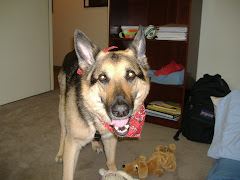



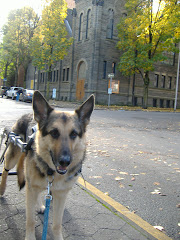
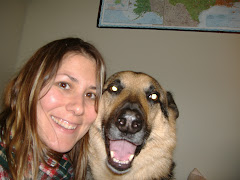


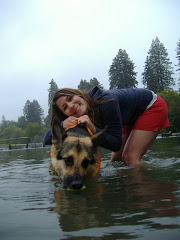_9_19_08+030.jpg)


_9_19_08+045.jpg)
_9_19_08+001.jpg)

